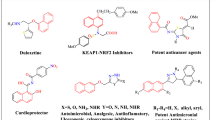Abstract
Introduction
Since the synthesis of acetylsalicylic acid by Hoffmann in 1897, new classes of NSAIDs have been introduced; however, their side effects have limited their clinical applications. Consequently, our team has recently synthesized a novel bipyrazole compound that showed a satisfactory efficacy and safety profile. The aim of the current study was to elucidate the molecular mechanism of this bipyrazole compound.
Method
The anti-inflammatory efficacy of the compound was assessed using formalin-induced paw edema test. Computer-assisted simulation docking experiments were carried out. Cyclooxygenase-2 (COX-2), inducible nitric oxide synthase (iNOS), neuronal nitric oxide synthase (nNOS), tumor necrosis factor-alpha (TNFα), interleukin-1 (IL1) and interleukin-10 (IL10) gene expression were quantified with real-time polymerase chain reaction (RT-PCR) using SYBR Green technology. The samples were taken from the plantar paw of mice after formalin local injection.
Results
The efficacy of the bipyrazole compound was similar to that of indomethacin, diclofenac, and celecoxib, as proven by the formalin-induced paw edema. Docking study indicated a superior binding score for the studied compound relative to celecoxib, indomethacin, and diclofenac. RT-PCR assessment revealed a significant decrease in iNOS, COX-2, and TNFα gene expression in the bipyrazole-treated group. Moreover, a reduction in IL1 and nNOS gene expression levels and an increase in IL10 level were detected despite being insignificant compared to the control group.
Conclusion
These findings revealed the superiority of the newly synthesized bipyrazole compound not only on the binding site, but also by inhibiting most of the inflammatory mediators including TNF-α.








Similar content being viewed by others
References
Brune K, Hinz B. The discovery and development of anti-inflammatory drugs. Arthritis Rheum. 2004;50:2391–9.
Jones R. Nonsteroidal anti-inflammatory drug prescribing: past, present, and future. Am J Med. 2001;110:4S–7S.
Vane JR, Botting RM. Mechanism of action of nonsteroidal anti-inflammatory drugs. Am J Med. 1998;104(Suppl 3A):2S–8S.
Ambranson SB, Weissmann G. The mechanisms of action of nonsteroidal anti-inflammatory drugs. Arthritis Rheum. 1989;32(1):1–9.
Praveen Rao PN, Knaus EE. Evolution of nonsteroidal anti-inflammatory drugs (NSAIDs): cyclooxygenase (COX) inhibition and beyond. J Pharm Pharm Sci 2008;11(2):81s–110s.
Davies NM, Good RL, Roupe KA, Yanez JA. Cyclooxygenase-3: axiom, dogma, anomaly, enigma or splice error? Not as easy as 1, 2, 3. J Pharm Pharm Sci. 2004;7:217–26.
Mizushima T. Molecular mechanism for various pharmacological activities of NSAIDs. Pharmaceuticals. 2010;3:1614–36.
Hilario MOE, Terreri MT, Len CA. (2006). Nonsteroidal anti-inflammatory drugs: cyclooxygenase 2 inhibitors. J Pediatr 82(5): s206-212.
Lavigne P, Shi Q, Joliccoeur FC, Pelletier JP, Martel-Pelletier J, Fernandes JC. Modulation of IL-1 beta, IL-6, TNF-alpha and PGE(2) by pharmacological agents in explants of membranes from failed total hip replacement. Osteoarthr Cartil. 2002;10(11):898–904.
Deb PK, Mailabaram RP, Al-Jaidi B, Saadh M. Molecular basis of binding interactions of NSAIDs and computer-aided drug design approaches in the pursuit of the development of cyclooxygenase-2 (COX-2) selective inhibitors. Nonsteroidal Anti Inflamm Drugs. 2017;6:101–21.
Mohy El-Din MM, Senbel AM, Bistawroos AA, El-Mallah A, Nour El-Din NA, Bekhit NA, El Razik HAA. A novel COX-2 inhibitor pyrazole derivative proven effective as an anti-inflammatory and analgesic drug. Basic Clin Pharmacol Toxicol. 2010;108:263–273.
Thore SN, Gupta SV, Baheti KG. Novel ethyl-5-amino-3-methylthio-1H-pyrazole-4-carboxylates: synthesis and pharmacological activity. J Saudi Chem Soc. 2012;06:(011).
Maddila S, Sampath SGCH, Lavanya P. Synthesis and anti-inflammatory activity of some new 1,3,4-thiadiazoles containing pyrazole and pyrrole nucleus. J Saudi Chem Soc. 2012;11:007.
Paprocka R, Wiese M, Eljaszewicz A, Helmin-Basa A, Gzella A, Modzelewska-Banachiewicz B, Michalkiewicz J. Synthesis and anti-inflammatory activity of new 1,2,4-triazole derivatives. Bioorg Med Chem Lett. 2015;25(13):2664–7.
Domiati S, Mehanna M, Ragab H, Nakkash-Chmaisse H, El Mallah A. Investigation of chronic efficacy and safety profile of two potential anti-inflammatory bipyrazole-based compounds in experimental animals. J Inflamm Res. 2018;11:143–53.
Vogel HG. Drug discovery and evaluation: pharmacologic assays, 3rd ed. Berlin: Springer; 2008.
Wang JL, Limburg D, Graneto MJ, Springer J, Hamper JR, Liao S, Pawlitz JL, Kurumbail RG, Maziasz T, Talley JJ, Kiefer JR, Carter J. Structure of celecoxib bound at the COX-2 active site. Bioorg Med Chem Lett. 2010;20:7159–63.
Chemical Computing Group Inc. (2009) Molecular operating environment (MOE) 2009.10. Montreal, Canada. http://www.chemcomp.com. Accessed 31 March 2018.
Brunton LL, Chabner BA, Knollmann BC. Anti-inflammatory, antipyretic & analgesic agents; pharmacotherapy of gout. In: Goodman, Gilman’s, editors. The pharmacological basis of therapeutics. 12th ed, California, Chap. 34, 2011.
Feghali CA, Wright TM. Cytokines in acute and chronic inflammation. Front Biosci. 1997;2:12–26.
Choy EH, Kingsley GH, Panayi GS. Monoclonal antibody therapy in rheumatoid arthritis. Rheumatology. 1998;37(5):484–90.
Cattell V, Jansen A. Inducible nitric oxide synthase in inflammation. Histochem J. 1995;27(10):777–84.
Sharma JN, Al Omran A, Parvathy SS. Role of nitric oxide in inflammatory diseases. Inflammopharmacology. 2007;17:252–9.
Korhonen R, Lahti A, Kankaanranta H, Moilanem E. Nitric oxide production and signaling in inflammation. Curr Drug Targets Inflamm Allergy. 2005;4:471–9.
Author information
Authors and Affiliations
Corresponding author
Additional information
Responsible Editor: John Di Battista.
Publisher’s Note
Springer Nature remains neutral with regard to jurisdictional claims in published maps and institutional affiliations.
Rights and permissions
About this article
Cite this article
Domiati, S., Mehanna, M., Ragab, H. et al. Elucidation of the molecular mechanism underlying the anti-inflammatory activity of an effective and safe bipyrazole-based compound. Inflamm. Res. 68, 379–386 (2019). https://doi.org/10.1007/s00011-019-01225-z
Received:
Revised:
Accepted:
Published:
Issue Date:
DOI: https://doi.org/10.1007/s00011-019-01225-z




